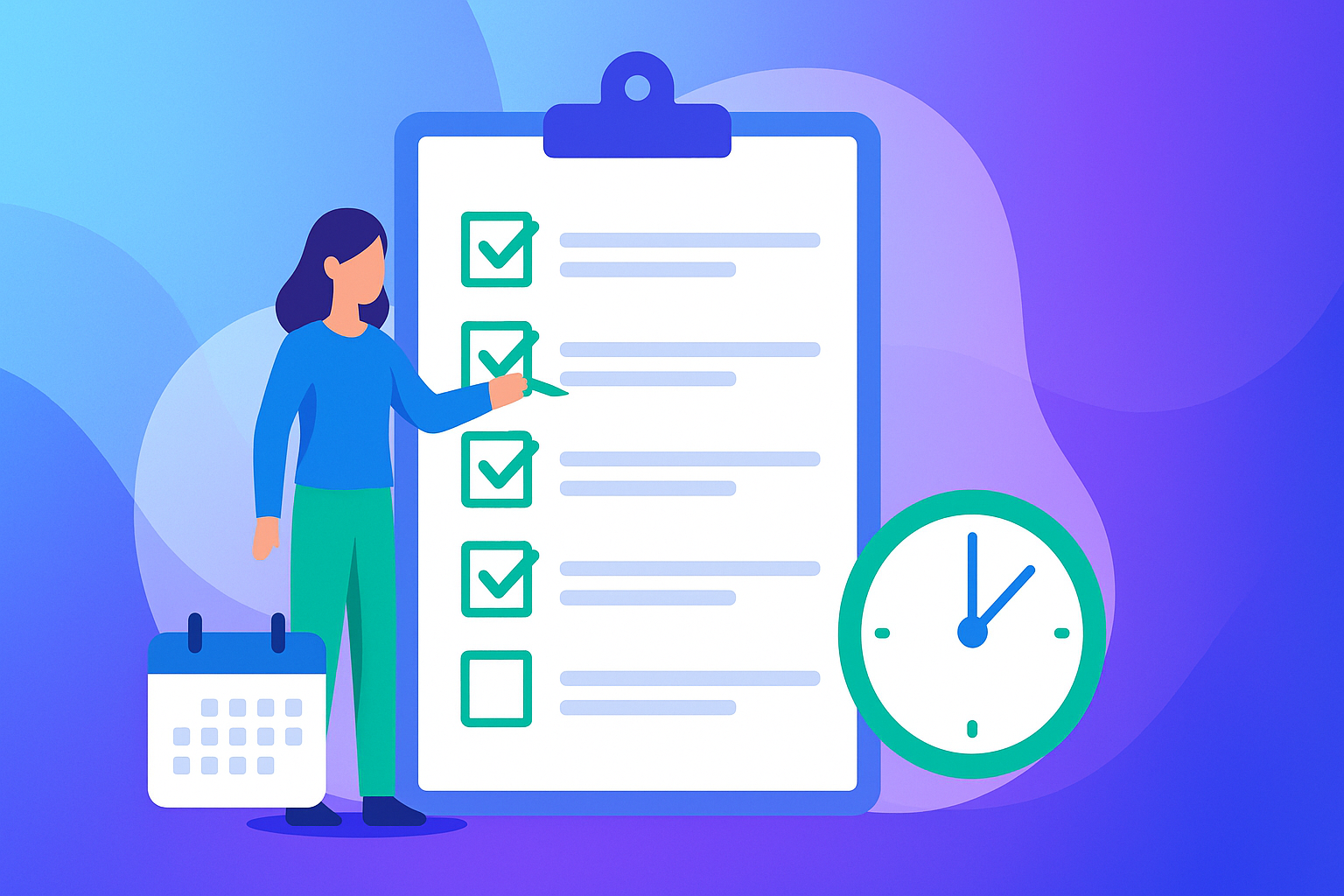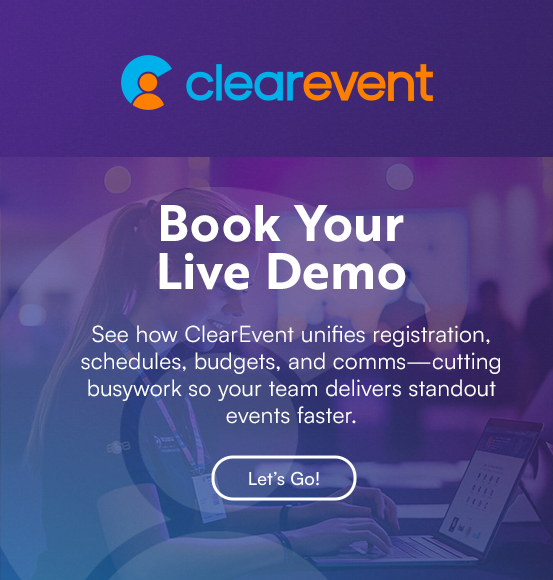Event Planning Checklists: A Practical 5-Step Guide

If you’ve ever felt overwhelmed by endless moving parts, checklists bring order to the chaos. They simplify event planning, improve organization and task management, and keep event execution on track so you can deliver success with less stress.
Why checklists work for event planning
- Clarity: Break complex projects into bite-size tasks so nothing is missed.
- Accountability: Assign owners and due dates so task management is visible.
- Consistency: Reuse what works and refine after each event to boost event success.
Step 1: Set goals, scope, and constraints
Before you build checklists, define what you’re trying to achieve.
Identify objectives
Are you launching a product, raising funds, growing membership, or hosting a community meetup? Write 1–3 measurable goals (e.g., “300 registrations,” “75% session attendance,” “NPS ≥ 50”).
Know your audience
Size, accessibility needs, dietary preferences, and travel patterns shape your plan. A 50-person local mixer differs from a 500-person association conference.
Lock the guardrails
- Budget: Create rough event budget caps for venue, catering, production, marketing, and contingency (5–10%).
- Timeline: Work backward from the event date; add buffers for approvals and vendor lead times.
- Location: Capture capacity, parking, accessibility, AV, insurance, and catering rules.
Pro tip: Write your goals at the top of your checklist. If a task doesn’t serve a goal, question it.
Step 2: Organize tasks into phases
Phasing keeps organization and task management focused.
- Planning (3–6 months out): Venue shortlist, contracts, budget approvals, core schedule, and initial marketing.
- Promotion (6–8 weeks out): Launch event registration, speaker confirmations, sponsor outreach, paid/organic campaigns.
- Event execution (final 2–3 weeks): Final headcounts, run-of-show, staff/volunteer briefings, vendor confirmations.
- Wrap-up (post-event): Invoices, thank-yous, reporting, survey, and debrief.
Use clear headings in your master checklist so owners see what matters now versus later.
Step 3: Build a master checklist framework
Group tasks so teams can work efficiently without duplication or confusion.
Core categories
- Venue & logistics: Site visits, floor plan approvals, insurance, permits, delivery windows.
- Vendors: Shortlists, quotes, contracts, deposits, confirmations, day-of contacts.
- Marketing & registration: Landing page, email series, social plan, media assets, FAQs.
- Staff & volunteers: Recruiting, role descriptions, training, shift schedules, comms plan.
- Budget & compliance: PO process, invoice dates, tax requirements, reconciliation.
- Post-event: Survey, NPS, content wrap, sponsor reporting, lessons learned.
Task details (make every line actionable)
- Due date: With a small buffer (e.g., internal deadline 1 week before vendor cutoffs).
- Owner + backup: Named people, not teams.
- Dependencies: “Order signage after sponsor logos are approved.”
- References: File paths, contract IDs, contact info.
- Cost notes: Caps or approval thresholds.
Copy/paste template:
Task | Owner/Backup | Due | Status (Not Started/In Progress/Blocked/Complete) | Dependency | Notes/Links | Budget
Step 4: Turn the framework into reusable templates
Templates reduce ramp-up time and support consistent event execution.
Timeline (Gantt-style) anchors
- Venue contract signed: 12+ weeks out
- Speakers confirmed: 10 weeks out
- Registration launch: 8 weeks out
- Final headcount to vendors: 2 weeks out
Helpful sub-checklists
- Staffing: Training agenda, check-in scripts, 30-minute shift overlaps, emergency tree.
- Risk: Weather backup, AV test 24 hours prior, vendor cancellation plan, incident log.
- Communication: Save-the-date → reminder cadence, day-before “know before you go,” on-site alerts.
- Vendors: Load-in/out windows, dock access, insurance certs, final invoices.
Centralize your docs
Keep contracts, floor plans, and comms templates in one shared location. Link those files directly from the tasks to reduce hunting and hand-offs.
Step 5: Assign, track, and improve
Make ownership obvious
Replace “handle catering” with “Finalize menu by Fri; confirm headcount by 15th; sign contract by 20th.”
Right-size the cadence
- Weekly updates when tasks are 8–12 weeks out
- Twice-weekly when 2–4 weeks out
- Daily stand-ups in the final 7 days
Use simple status labels
Not Started / In Progress / Blocked / Complete. Ask “What’s blocking this?” early to avoid cascades.
Close the loop post-event
- Send attendee survey within 48–72 hours.
- Hold a team debrief within 7 days.
- Compare outcomes to goals and budget; update templates with lessons learned (date-stamped).
Day-of checklist: Run-of-show
A detailed run-of-show is your event execution playbook.
- Venue walkthrough and signage check
- Vendor arrivals (staggered windows), AV tests, safety checks
- Registration open: scanners/tablets tested; accessibility support visible
- Session cues, speaker handoffs, catering timing
- End-of-day reset, lost-and-found, venue walkout, closing comms
Badge printing: If applicable, confirm with your preferred vendor or on-site solution well in advance.
How ClearEvent helps you manage checklists
Managing checklists in one place improves organization and task management. Tools like ClearEvent’s all-in-one event management platform centralize planning so teams can focus on event execution.
- Task lists with owners and deadlines: Create detailed tasks, add notes and file links, and track real-time status. No more scattered spreadsheets.
- Deadline reminders and centralized views: Keep due dates visible and surface what needs attention now.
- Mobile Event Web App (browser-based): On event day, staff and volunteers can view tasks, schedules, and updates on their phones, no app download required.
- Role-aware schedules & job assignments: Share the public schedule and provide role-specific itineraries. Assign volunteer shifts and responsibilities so handoffs are clear.
- Registration to checklist alignment: Use final headcounts and dietary notes from registration to power catering and staffing tasks.
Checklists are the backbone of successful event planning. When you define goals, phase the work, build a reusable framework, and track ownership clearly, event execution becomes calmer and event success more repeatable. Start small, build your first version, then refine after every event.
Want a ready-to-use event checklist tailored to your needs? Schedule a personal demo and see how ClearEvent can simplify your next event.
Frequently Asked Questions (FAQ)
How detailed should an event planning checklist be? Your checklist should be detailed enough that anyone on your team could pick up a task and know exactly what to do. Include owners, deadlines, and dependencies, but avoid overloading with unnecessary notes that slow progress.
What tools are best for managing event checklists? Spreadsheets can work for smaller events, but dedicated event management platforms help keep everything in one place. Tools like ClearEvent provide task assignment, reminders, and real-time updates that make collaboration easier.
How far in advance should I start building an event planning checklist? Start at least 3–6 months before larger events and 4–8 weeks before smaller gatherings. This gives you enough time to secure venues, confirm vendors, and launch registration without last-minute stress.
Can checklists help with volunteer management at events? Yes. Create sub-checklists for recruiting, training, and shift scheduling. Assign tasks clearly and give volunteers access to schedules through a mobile-friendly tool so everyone knows their role on event day.
How do I adapt a checklist for recurring events? Save your master checklist as a template and update it after every event with lessons learned. Over time, this living document becomes more accurate and helps you scale recurring events with less effort.
